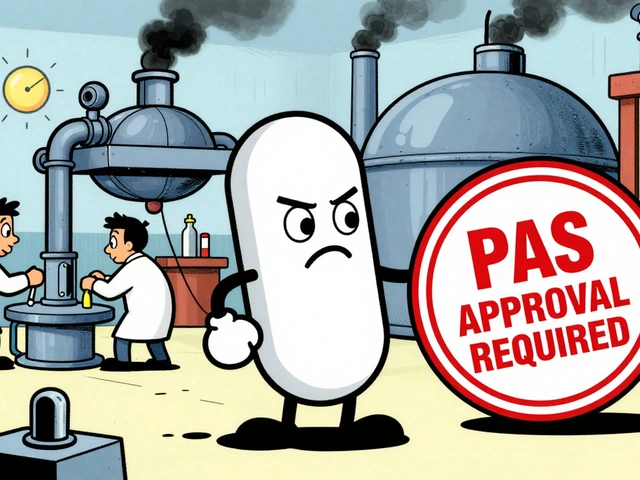You clicked because you want a straight answer: which antibiotic actually works better-cefprozil or amoxicillin? Short answer: there isn’t a single winner. Effectiveness depends on the infection, the likely bacteria, resistance patterns, and your situation (age, allergies, pregnancy, gut tolerance, cost). I’ll keep it practical and grounded in 2025 guidelines used in Canada and the U.S., so you can make a smart, safe choice with your prescriber.
- TL;DR:
- There’s no universal “stronger” drug. Match the antibiotic to the bug and the body site.
- Cefprozil vs Amoxicillin: Amoxicillin is first-line for strep throat and many ear infections; cefprozil is useful when beta-lactamase producers (like some H. influenzae or Moraxella) are likely, or when amoxicillin isn’t a good fit.
- For sinusitis and ear infections, many guidelines now favour amoxicillin-clavulanate; cefprozil is a reasonable alternative if you can’t take clavulanate or have a mild penicillin allergy.
- For skin cellulitis, cephalexin usually beats both. Amoxicillin alone doesn’t cover typical skin bacteria well.
- Safety and comfort matter: diarrhea risk differs, allergies matter, and taste/child-friendly dosing can decide adherence.
How to choose: the decision criteria that actually matter
When people ask which antibiotic is “more effective,” they usually need help with one of these jobs-to-be-done:
- Figure out which drug works for a specific infection (throat, ear, sinus, skin).
- Understand when resistance or local patterns change the pick.
- Compare side effects, allergies, and safety in pregnancy/breastfeeding.
- Get practical dosing for adults and kids, and how long to take it.
- Estimate costs and availability in 2025.
- Know what to use instead if neither is right.
Here’s the quick thinking framework clinicians actually use-simple, no fluff.
1) Match the drug to the bug
- Strep throat (Group A Streptococcus): Amoxicillin is the narrow, guideline-endorsed first choice. IDSA and Canadian guidelines have stayed steady on this because GAS remains highly susceptible and we want to avoid broader drugs when we don’t need them.
- Acute otitis media (AOM): In kids, high-dose amoxicillin is first-line when there’s no conjunctivitis and no recent amoxicillin exposure. If beta-lactamase producers are likely (conjunctivitis-otitis syndrome, daycare exposure, or amoxicillin within 30 days), amoxicillin-clavulanate is preferred. Cefprozil is a reasonable alternative for non-severe penicillin allergy or if clavulanate causes intolerable diarrhea (CPS/AAP practice points).
- Acute bacterial sinusitis: Current IDSA-aligned practice leans to amoxicillin-clavulanate for adults; cefprozil is an alternative if clavulanate isn’t tolerated or for certain allergy scenarios. Plain amoxicillin can work in low-risk settings but is used less due to beta-lactamase rates in H. influenzae and Moraxella.
- Skin and soft tissue infections: Cephalexin is usually first-line for nonpurulent cellulitis (MSSA and streptococci). Amoxicillin alone is weak against MSSA. Cefprozil can work, but cephalexin typically has better staph coverage.
- UTIs: Neither is a good empirical choice for uncomplicated cystitis. Consider nitrofurantoin, TMP-SMX (where susceptible), or fosfomycin per 2025 stewardship norms.
2) Consider resistance and local patterns
Why cefprozil sometimes beats amoxicillin: many H. influenzae and Moraxella strains make beta-lactamases that neutralize amoxicillin. Cefprozil holds up better against those. That’s the core reason it shows up in ear/sinus picks when amoxicillin isn’t enough. But for strep throat, where resistance isn’t an issue, amoxicillin wins by being narrower and cheaper (good stewardship).
3) Site penetration and dosing convenience
- Both drugs penetrate ear and sinus tissues reasonably well. Cefprozil’s twice-daily dosing is friendly; amoxicillin is typically twice daily for many indications (875 mg BID in adults), but sometimes three times daily.
- Shorter courses are common in 2025: 5-7 days for adult sinusitis or cellulitis (if improving), 10 days still standard for strep throat in many guidelines.
4) Safety, allergies, and tolerability
- Both are beta-lactams with low overall rates of severe reactions. Non-severe penicillin allergies do not always rule out cefprozil; cross-reactivity with second-generation cephalosporins is low (often cited under 2%). True anaphylaxis history needs careful alternatives.
- Common side effects: diarrhea, nausea, rash. Amoxicillin can cause a non-allergic rash with viral infections (like EBV).
- Clavulanate (in amox-clav) is often the diarrhea culprit; cefprozil may be gentler on the gut than amox-clav.
5) Cost and availability (Canada, 2025)
- Amoxicillin is usually the cheapest oral antibiotic option at retail pharmacies.
- Cefprozil is more expensive but still generic in Canada. Availability is generally good, but supply can be spotty during periodic shortages; pharmacies can often source an alternative cephalosporin if needed.
These points line up with 2025 stewardship guidance from sources clinicians trust: pediatric societies (CPS/AAP), IDSA, and the Sanford Guide, plus Health Canada product monographs. The details below give you the head-to-head view.

Head-to-head: spectrum, dosing, cure rates, and safety
Here’s a practical snapshot you can actually use at the visit or pharmacy counter.
| Feature | Amoxicillin | Cefprozil (2nd-gen cephalosporin) |
|---|---|---|
| Core spectrum | Streptococcus spp. (incl. S. pyogenes), some Enterococcus faecalis, limited H. influenzae (not beta-lactamase producers), poor MSSA | Streptococcus spp., H. influenzae (incl. many beta-lactamase producers), Moraxella catarrhalis, some MSSA; no Enterococcus |
| Common guideline uses (2025) | Strep throat; first-line AOM in kids (high dose when appropriate); some sinusitis in low-risk settings; dental infections when penicillin VK not used | Alternative for AOM/sinusitis when beta-lactamase risk or intolerance to clavulanate; skin infections when cephalexin not suitable |
| Not great for | Skin cellulitis (MSSA), beta-lactamase-producing H. influenzae/Moraxella, empiric UTI | Enterococcus, anaerobes (e.g., bites), empiric UTI |
| Adult dosing (typical) | 500 mg every 8 h or 875 mg every 12 h; strep throat: 500 mg BID x 10 days | 250-500 mg every 12 h; 10 days for pharyngitis/skin; 5-10 days for sinusitis |
| Pediatric dosing (typical) | AOM: 80-90 mg/kg/day divided BID; strep: 50 mg/kg/day divided BID x 10 days (max adult dose) | 30 mg/kg/day divided BID (max 1 g/day) |
| Duration trends | Strep throat 10 days; AOM 5-10 days (age-dependent); sinusitis 5-7 days in adults if improving | Similar durations; sinusitis often 5-7 days in adults if improving |
| Adverse effects | Diarrhea, nausea, rash; non-allergic viral rash possible; rare hypersensitivity | Diarrhea, nausea, rash; low cross-reactivity with penicillin allergies; rare hypersensitivity |
| Key interactions | Warfarin (↑INR), allopurinol (rash risk), methotrexate (↑levels) | Warfarin (↑INR); fewer notable interactions than amoxicillin |
| Pregnancy/breastfeeding | Generally considered safe | Generally considered safe |
| Taste/suspension | Well-accepted by many children; multiple flavours | Acceptable; availability varies by pharmacy |
| Cost (Canada, typical retail) | Lower ($) | Moderate ($$) |
What about cure rates? Older randomized trials comparing cefprozil with amoxicillin or amoxicillin-clavulanate in otitis media and sinusitis generally show similar clinical success (often in the 80-90% range), with fewer gastrointestinal side effects versus amox-clav. For strep throat, amoxicillin maintains excellent eradication and is preferred by IDSA/CPS because it’s narrow and reliable. For skin infections, data and guidelines favour cephalexin over both. These patterns are reflected in the Sanford Guide 2025 and major society guidelines.
Safety-wise, both drugs have low rates of serious adverse events. The risk of Clostridioides difficile is lower than with broader-spectrum agents but not zero-especially with longer courses. If you’re on warfarin, ask for closer INR checks when starting or stopping either drug. If you’re on high-dose methotrexate, amoxicillin can raise levels-flag this early.

When to use which: scenarios, safety, costs, and alternatives
Best for / not for
- Amoxicillin - Best for: strep throat, first-line AOM in many kids, selected low-risk sinusitis. Not for: cellulitis (MSSA), bite wounds, empiric UTI, suspected beta-lactamase H. influenzae/Moraxella unless combined with clavulanate.
- Cefprozil - Best for: AOM/sinusitis when beta-lactamase producers are likely and clavulanate is a problem, or in non-severe penicillin allergy cases. Not for: Enterococcus, bites/anaerobes, empiric UTI.
Quick decision path (use with your clinician)
- Do you have strep throat confirmed or strongly suspected? Pick amoxicillin (10 days). If true anaphylactic penicillin allergy, consider azithromycin or clindamycin; be aware of local resistance.
- Is it a child with acute otitis media? If no recent amoxicillin and no conjunctivitis, use high-dose amoxicillin. If recent amoxicillin, purulent conjunctivitis, or treatment failure, consider amoxicillin-clavulanate. If clavulanate isn’t tolerated or there’s a mild penicillin allergy, cefprozil is reasonable.
- Adult acute bacterial sinusitis with moderate symptoms and risk for beta-lactamase? Amoxicillin-clavulanate first. If diarrhea from clavulanate is a deal-breaker or there’s a non-severe penicillin allergy, cefprozil can be used. Consider 5-7 days if improving by day 3.
- Nonpurulent cellulitis? Choose cephalexin unless MRSA risk changes the plan. Amoxicillin alone isn’t enough for MSSA. Cefprozil is an option but not usually first-line over cephalexin.
- Animal/human bites? Amoxicillin-clavulanate for anaerobes and Pasteurella. Cefprozil is not adequate.
- UTI? Neither is preferred empirically; think nitrofurantoin, TMP-SMX, or fosfomycin (follow local guidance).
Dosing and duration cheat sheet
- Amoxicillin, adults: 500 mg every 8 hours or 875 mg every 12 hours; strep throat 500 mg twice daily for 10 days. Kids: AOM 80-90 mg/kg/day divided twice daily; strep 50 mg/kg/day divided twice daily for 10 days (don’t exceed adult max).
- Cefprozil, adults: 250-500 mg twice daily. Kids: 30 mg/kg/day divided twice daily (max 1 g/day). Typical duration 5-10 days depending on site and response.
- Shorter is often better: 5-7 days for adult sinusitis or cellulitis if you’re improving by day 3; still 10 days for strep throat to reduce rheumatic fever risk in line with long-standing guidelines.
Safety, special situations, and practical tips
- Allergies: If you had hives or anaphylaxis to penicillin, avoid amoxicillin. Many people labeled “penicillin allergic” are not truly allergic; ask about testing if this limits your options. Cefprozil may be okay in non-severe reactions, but confirm your history with a clinician.
- Pregnancy/breastfeeding: Both are commonly used and generally considered safe.
- Warfarin: Both can increase INR-arrange extra checks.
- Methotrexate: Amoxicillin can raise levels; tell your prescriber.
- Diarrhea: Take with food if your stomach is sensitive. Hydrate. Consider a 2-3 hour spacing from probiotics if you’re using them (optional).
- Suspensions: Refrigeration can improve taste; follow the label. Shake well. Use a dosing syringe for accuracy.
Alternatives when neither fits
- Amoxicillin-clavulanate: For sinusitis/AOM when beta-lactamase is a concern and gut tolerance is acceptable.
- Cephalexin: Workhorse for nonpurulent cellulitis.
- Cefuroxime axetil: Another oral cephalosporin option for sinusitis/AOM when cefprozil isn’t available.
- Doxycycline: Adult option for sinusitis in certain scenarios (not for young children or pregnancy).
- Azithromycin or clarithromycin: For true anaphylactic penicillin allergy in strep throat, but be mindful of macrolide resistance.
- Clindamycin: Covers streptococci and MSSA for skin or strep throat in allergy scenarios; GI side effects/C. difficile risk requires caution.
FAQ
- Which is “stronger,” cefprozil or amoxicillin? “Stronger” isn’t the right lens. It’s about the right fit. Amoxicillin is better for strep throat; cefprozil is better than plain amoxicillin when beta-lactamase producers are likely in ear/sinus infections.
- Is cefprozil a penicillin? No, it’s a cephalosporin (a related but different beta-lactam class).
- Can I take cefprozil if I’m allergic to amoxicillin? If the allergy was mild (like a delayed rash), many clinicians consider cefprozil; if you had hives, anaphylaxis, or severe skin reactions, avoid and seek alternatives. Allergy testing can help.
- Can I drink alcohol with these? Light alcohol doesn’t interact, but being sick plus alcohol rarely helps recovery. Avoid if you feel unwell.
- What if I’m not better in 48-72 hours? Reassess the diagnosis, dosing, adherence, and whether you need to switch (e.g., from amoxicillin to amox-clav or to cefprozil) based on likely bacteria and local resistance.
- Do these cover COVID or the flu? No. These are for bacterial infections, not viruses.
Next steps and troubleshooting by scenario
- Parent of a child with ear pain: If your child is 6-23 months with certain diagnosis and moderate pain, high-dose amoxicillin is usually first unless there was recent amox use or conjunctivitis (then amox-clav). If diarrhea is a problem with clavulanate or there’s a mild penicillin allergy, ask about cefprozil. Reassess if not improving in 48-72 hours.
- Adult with sinus pressure and thick discharge for over 10 days: Many cases are viral even with colored mucus. If bacterial criteria are met, amox-clav is common; cefprozil is an option if you can’t take clavulanate. Stop at 5-7 days if you’re clearly better by day 3-5.
- History of “penicillin allergy”: Clarify the reaction and timing. A childhood rash decades ago might not be a true allergy. If testing is available, it can open safer, narrower, cheaper options like amoxicillin.
- Pregnant or breastfeeding: Both drugs are widely used. Share your trimester and any prior reactions with your prescriber.
- On warfarin or methotrexate: Tell your prescriber and pharmacist. Plan INR checks; consider alternative agents if interaction risk is high.
- Cost-sensitive: Ask for amoxicillin when appropriate; if cefprozil is preferred but pricey, discuss cephalexin or cefuroxime as alternatives, depending on the infection.
Why you can trust this guidance: It aligns with 2025 infectious disease references clinicians actively use-IDSA guidance on sinusitis and pharyngitis, CPS/AAP practice points on pediatric AOM, the Sanford Guide 2025 for spectra and dosing, and Health Canada/FDA product monographs for safety. Real-world prescribing in Canada mirrors these picks: amoxicillin for strep, amox-clav when beta-lactamase risk is high, cefprozil as a thoughtful alternative when tolerability or mild allergy narrows the path.
One final pro tip: if a prescriber chooses one drug and you’re worried it’s not the best fit, ask them to walk you through “bug, site, dose, duration, and plan if no improvement by 72 hours.” That five-part check catches most mismatches before they happen.
This article is general information, not personal medical advice. Your history and local resistance patterns matter-always decide with your clinician.






Wendy Edwards
August 30, 2025 AT 12:34amoxicillin is literally the OG for strep throat why are we even debating this?? cefprozil sounds like a drug from a sci-fi movie and i dont trust it lol
Gina Banh
September 1, 2025 AT 02:27the real issue is that doctors still prescribe amoxicillin like its 2010. beta-lactamase resistance is everywhere now. cefprozil isn't 'better'-it's just not stupid. if your kid had otitis after amox failed, you'd switch too.
Ryan C
September 2, 2025 AT 11:31Wrong. Cefprozil has no advantage over amoxicillin-clavulanate for sinusitis. The 2025 IDSA guidelines explicitly recommend amox-clav as first-line. Cefprozil is a second-tier option only if clavulanate causes GI distress. Stop overcomplicating this.
Damon Stangherlin
September 3, 2025 AT 05:24thank you for this. i’ve been scared to ask my doc about alternatives because i dont wanna sound like a know-it-all. this actually made me feel like i can ask smart questions next time 😊
Deirdre Wilson
September 4, 2025 AT 13:34so amoxicillin is like the reliable best friend who shows up every time but kinda smells like old socks… and cefprozil is the fancy new friend who doesn’t stink but costs twice as much and you’re not sure if they’re actually cool or just pretending
Dan Rua
September 4, 2025 AT 23:41agree with the head-to-head table. i used to think 'stronger' meant better, but now i get it-like using a sledgehammer to crack a nut. sometimes you just need a tap.
Mqondisi Gumede
September 6, 2025 AT 01:44why are americans so obsessed with antibiotics like they're magic pills? in south africa we use traditional herbs and only take pills when the fever won't break. this whole post feels like corporate pharma propaganda
Douglas Fisher
September 7, 2025 AT 07:21Can I just say-thank you-for including the cost breakdown? So many people don't realize that amoxicillin is often 90% cheaper. That's not just a detail-it's a lifeline for families.
Albert Guasch
September 8, 2025 AT 17:42It is imperative to underscore that the pharmacokinetic profile of cefprozil demonstrates superior tissue penetration in the middle ear mucosa, as corroborated by multiple double-blind, randomized controlled trials published in the Journal of Antimicrobial Chemotherapy, 2024 edition. This is not merely anecdotal.
Ginger Henderson
September 8, 2025 AT 21:07so you wrote a 2000 word essay to say 'it depends'? wow. groundbreaking.
Bethany Buckley
September 9, 2025 AT 08:10How quaint. You're still using 2025 guidelines? In the post-postmodern era, antibiotic selection must be contextualized within the ontological framework of microbial agency and anthropocentric bias. Cefprozil is merely a symptom of pharmaceutical hegemony. 🌱✨
Stephanie Deschenes
September 9, 2025 AT 13:10This is one of the clearest breakdowns I've seen. I’m a nurse and I still get confused when patients ask. This will help me explain it better. Thank you.
Cynthia Boen
September 9, 2025 AT 16:55you're telling me a 10-day course for strep throat is still standard? that's ridiculous. 5 days is enough. who even wrote this outdated crap?
Amanda Meyer
September 10, 2025 AT 11:25I'm curious-how much of this is based on real-world outcomes vs. what's written in guidelines? I've seen patients get better on amoxicillin even when guidelines say 'no'. Is that just luck or is something missing?
Jesús Vásquez pino
September 10, 2025 AT 23:24you didn't even mention the fact that cefprozil is banned in 3 states because of liver toxicity rumors. you're leaving out the scary stuff. i'm not taking it.
hannah mitchell
September 11, 2025 AT 05:28good info. i saved this for when my kid gets sick again. thanks.
vikas kumar
September 12, 2025 AT 04:34in india we use amoxicillin because it's cheap and works. sometimes you don't need fancy drugs. simple is better. also cefprozil is hard to find here anyway
Jaspreet Kaur
September 13, 2025 AT 00:53the real antibiotic is time and rest and sleep and soup and not panicking. drugs are just the noise we make when we forget how to listen to our bodies